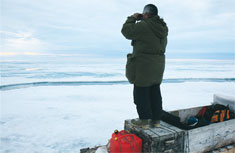
Indigenous knowledge and science
Inuit forecasters with generations of environmental knowledge help scientists understand more about Arctic weather
An Inuk living in the Canadian Arctic looks to the sky and can tell by the way the wind scatters a cloud whether a storm is coming. Thousands of miles away in a Boulder laboratory, scientists collect data and use computer models to make similar weather predictions. These distinct practices serve the same purpose.
But in the past 20 years, something's run amok with Inuit forecasting. Old weather signals don't mean what they used to. The cloud that scatters could signal a storm that comes in an hour instead of a day. Elsewhere, researchers had heard the reports from Arctic communities of unpredictable weather. But the stories didn't seem to match up with the researchers' models. By scientific measurement, weather around the world appeared to be growing more persistent with less variation. The disparity left scientists — including CIRES scientist Betsy Weatherhead, who has long been interested in the issue — scratching their heads.
Weatherhead contacted Shari Gearheard, a scientist with CIRES' National Snow and Ice Data Center,
who lives in Clyde River, Nunavut, Canada, an Inuit community on eastern Baffin Island. For the past 10 years, Gearheard has been working with Inuit hunters and elders — in their own language, which Gearheard speaks—to document their knowledge of the environment and environmental change.
Gearheard meticulously collects the stories told to her by the Inuit and makes systematic records of indigenous environmental knowledge. Through this, patterns begin to emerge, leading Weatherhead and colleague Distinguished Professor Roger Barry, a CIRES Fellow, to focus their analysis on patterns of weather "persistence" in the springtime.
Statistical analyses of day-to-day temperatures at Baker Lake, Nunavut, showed that during May to June, the persistence of temperature has recently declined, matching Inuit reports of greater unpredictability for that season.
The scientific analyses matched what the Inuits were witnessing on the ground. Weather along the Arctic latitudes was behaving more unpredictably than in other parts of the world.
"That's an incredibly important parameter to care about, incredibly important," said Weatherhead. "One way I describe it is if an inch of rain falls at my house in the month of July, I don't need to turn on the sprinklers. But if there is one inch of rain on July 1 and no rain after that, my lawn is dead."
"Ecosystems have evolved under a certain type of pattern. So if the pattern is changing, that could be just as important as a small increase in temperature or some of the other changes we're talking about," Weatherhead continued.
The study helps refine and test climate models, while also providing these models with a new category of information to consider. And Gearheard's work with the Inuit is demonstrating the value of indigenous environmental knowledge to modern climate science.
"Indigenous knowledge didn't always have the place it does now in research," Gearheard added. "It's growing. People are becoming more familiar with it, more respectful of it."![]()


